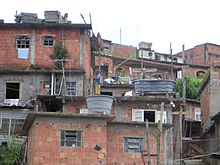Paula Lucci – Putting An Urban Dimension In Post-2015
www.globalpolicyjournal.com. April 2014. If we are to end poverty, we must think about urbanisation. The world’s population is becoming increasingly urban and the number of people living in slums is set to rise. Urban poverty and sustainability have been longstanding themes in the discussion on what should replace the Millennium Development Goals (MDGs) when they expire in 2015: the type of infrastructure built to accommodate these people in urban areas will have a bearing on sustainable development for decades to come. How might a new set of goals do a better job than the MDGs at addressing the problems and opportunities of urban areas?
While it’s clear that urbanisation and urban poverty need to be factored in to a new development agenda, working out how is much trickier. Urban poverty is defined by a number of dimensions: income, health and education are part of urban poverty, just as they are part of poverty in any other context. Further, urbanisation (the increasing share of population living in urban centres) is a dynamic and context-specific process: its consequences on the economy and poverty reduction, society and the environment depend on local circumstances and how this process is managed. As such, it does not lend itself to be easily framed in the SMART targets and indicators language of the MDGs.
Read more: http://www.globalpolicyjournal.com/putting-urban-dimension-post-2015
